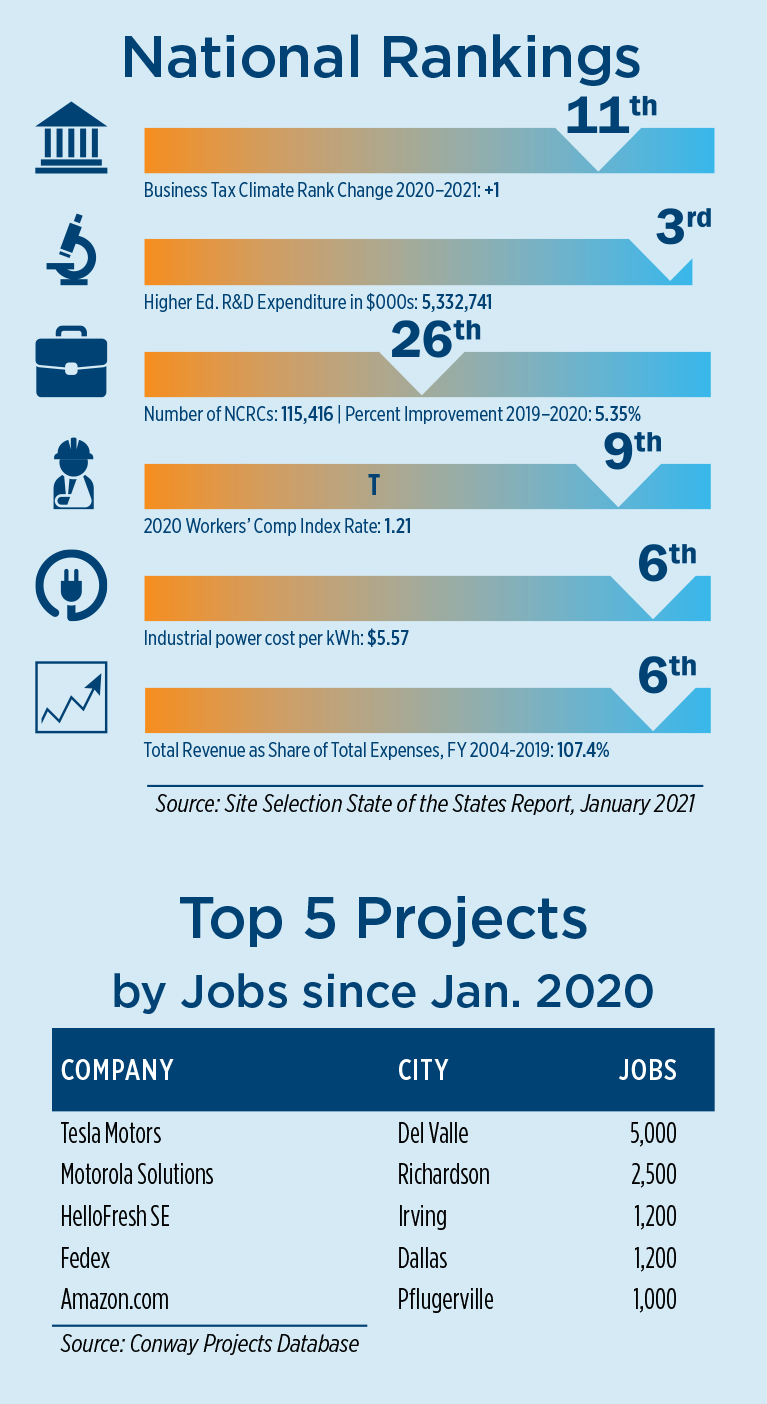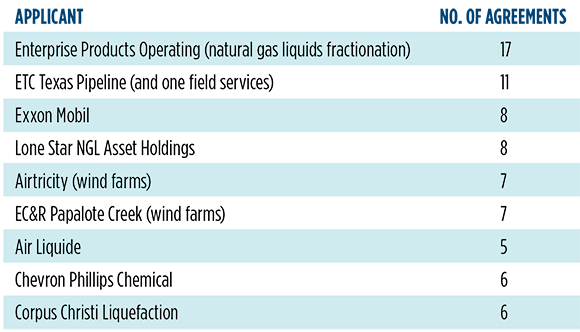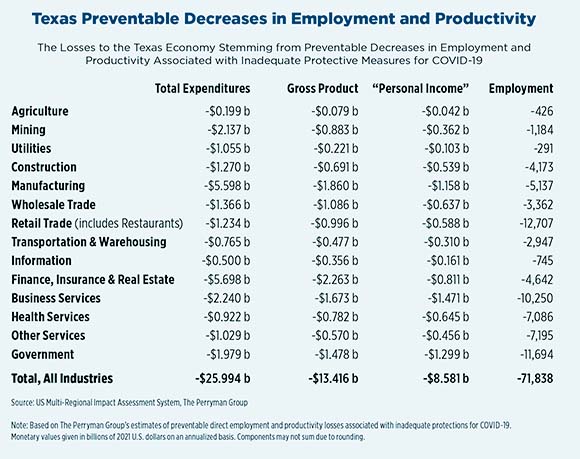
When we covered all sides of the Tesla blockbuster deal that landed in central Texas last year, Chapter 313 property tax abatements and related commitments to schools and training were a big part of the picture. Now it appears the widely used incentive program will be allowed to sunset next year, after a legislative measure introduced this year to extend it ran into a wall of opposition that instead voted to let it expire at the end of 2022. What does this mean for company projects? And what does it mean for the education and training programs relying on partnerships with companies benefiting from the incentive?
First, let’s turn to the Texas Comptroller of Public Accounts, where you can not only find a fully updated spreadsheet of all 591 active Chapter 313 agreements, but plenty of background documentation about the incentive’s origins and effectiveness. A 2016 “Fiscal Notes” story on the Comptroller’s website (see sidebar for the incentive’s mechanics) lays out the history:
“The 2001 Legislature’s Texas Economic Development Act, often called ‘Chapter 313’ for its position in the Texas Tax Code, allows public school districts to offer tax incentives for businesses that invest in their communities. The Chapter 313 incentive is designed to attract new businesses by offering them a 10-year limitation on their appraised property value for a portion of the school district property tax. In exchange for the value limitation, the business agrees to build or install new property and create jobs in the school district.
“Most of the local tax revenue the school district forgoes under Chapter 313 is replaced with state funding,” the analysis explains. “Thus the act uses state revenue to promote local economic development.”

"It is entirely appropriate to review Chapter 313 and other incentives to strengthen compliance and oversight and address perceived shortcomings. However, given the tax structure in Texas and the intense competition for economic development, this measure is vital."
— Ray Perryman, President and CEO, The Perryman Group
Site Selection magazine itself had an unwitting role in the program’s creation 20 years ago by the Texas Legislature. As reported by the Houston Chronicle in its recent series on the program called “Unfair Burden,” a calculation error in one of our published rankings of states decades ago led to alarm among some Texas legislators when the usually high ranking of their state had appeared to plummet. We corrected our error. But some say Texas is just now getting around to correcting its own.
Awareness of the program’s pitfalls is bipartisan, even as it’s been extended three times in the past.
“The program isn’t without its critics,” says that 2016 analysis from the Comptroller’s office. “In 2015, Gov. Greg Abbott vetoed legislation to expand Chapter 313 incentives to projects involving multiple, contiguous school districts. The governor’s veto stated that, ‘While the program may sometimes have a positive impact on local economic development, serious concerns exist about its oversight, its transparency, and its value to taxpayers.’ ”

In 2019 the Samsung Austin Semiconductor manufacturing facility joined Apple and eBay in procuring power from the 500-MW White Mesa Wind project in Crockett County, Texas. Developed by Apex Energy, the wind farm, like Samsung’s site, itself benefited from Chapter 313 incentives.
Photo courtesy of Samsung
How Chapter 313 Works
To improve the transparency of Chapter 313 projects, in 2009 the Texas Legislature required that Chapter 313 applications, economic impact evaluations and limitation agreements be posted on the Comptroller’s website. These excerpts from a 2016 “Fiscal Notes” article published by the Texas Office of the Comptroller explain how the program operates.
- An appraised value limitation is an agreement between a taxpayer and a school district in which the taxpayer proposes to build or install property — and create jobs meeting certain requirements — in exchange for a 10-year limitation on the taxpayer’s property value for tax purposes. For the term of the limitation agreement, the maintenance and operations portion of the property tax isn’t levied on property value in excess of the limitation amount. The property remains fully taxable for the other portion of local property taxes, the interest and sinking tax.
- Chapter 313 limitation amounts are set in state law and vary from $10 million to $100 million in property value. Companies seeking the limitation must submit an application and fee to the school district in which the project will be located.
- While Chapter 313 tax limitation agreements are made between individual companies and school districts, the Legislature has charged the Comptroller’s office with several duties related to them. Since 2013, the agency has been required to determine whether a proposed project is reasonably likely to generate, within 25 years, enough state taxes and local M&O tax revenue to offset the tax losses due to the limitation agreement. It also must find that the tax limitation is a determining factor in the applicant’s decision to invest and build in Texas. School districts cannot enter into Chapter 313 agreements without Comptroller certification.
- To qualify for a Chapter 313 property tax limitation, companies are required to make a minimum qualifying investment in the school district in which they seek to locate, varying from $1 million to $100 million. Minimum property value limitations they can receive in return vary from $10 million to $100 million, depending on the school district’s taxable property values and whether it is considered a rural or non-rural district.
- To be eligible for the tax limitation, a business must create a minimum of 25 “qualifying” jobs in non-rural school districts and 10 qualifying jobs in rural school districts. The statute allows this minimum number of jobs to be waived in certain circumstances, however, and more than half of applicants in fact receive such waivers.
- Qualifying jobs must provide certain healthcare benefits, offer the employee at least 1,600 hours of work per year and pay at least 110% of the average manufacturing wage for the county or the Council of Governments region in which the district is situated. The average wage of any other jobs created must exceed the county average wage for jobs in all industries.
‘Essential Program’
Under current law, industries eligible for Chapter 313 school property tax limitation include manufacturing; R&D; clean coal and other clean energy projects; renewable electricity generation; nuclear energy; data centers; and “Texas priority projects,” defined as those with a qualified investment commitment of more than $1 billion. Site Selection’s Conway Projects Database has tracked 34 facility investments of more than $1 billion in Texas (not all of which have Chapter 313 incentives agreements) since January 2002. They include Samsung’s most recent megaproject in Austin in 2016 and a bevy of petrochemical and energy projects.
There are 591 active Chapter 313 agreements. And as a potential $17 billion project from Samsung hangs in the balance, there appear to be two competing agreements on the table with different school districts. (Samsung benefited from a Chapter 313 agreement for a past multibillion-dollar investment in Austin.)
In its application for a Chapter 313 incentive agreement with the Manor school district for the new project, filed in early 2021, Samsung laid out the reasons for the ask:
“This project is highly competitive, and the company is looking at alternative sites in the U.S. including Arizona and New York, as well as abroad in Korea where Samsung Austin Semiconductor’s parent company is headquartered,” the application stated. “Because of its strong ties to the local community and the successful past 25 years of manufacturing in Texas, Samsung Austin Semiconductor would like to continue to invest in the city and the state. Due to the higher tax cost of operating in Texas, the appraised value limitation is a determining factor. Without the appraised value limitation award, the company would likely locate the project in Arizona, New York or Korea.”
The proposed agreement would save the company $252.9 million in school district taxes, but the project is estimated to have a local economic impact of $8.6 billion over its first 20 years of operation.
For insights into the value of the program, I reached out to Dr. Ray Perryman, president and CEO of The Perryman Group, an economic research and analysis firm based in Waco, Texas. Among other honors, Perryman in 2019 received the Chairman’s Award for Lifetime Achievement in Economic Development from the International Economic Development Council. In 2012 he received the Cesar E. Chavez Conscience Builders Award for his humanitarian work in such areas as hunger, indigent health care, poverty and child maltreatment. So he brings as balanced a viewpoint as anyone to the topic of incentives.
“Chapter 313 is an essential tool for Texas economic development professionals,” he says. “I was involved around and did original studies when Chapter 313 was enacted and implemented. It was clear even before enactment that it would fundamentally change the state’s ability to compete for capital-intensive projects, which has proved to be true. It remains crucial to encouraging new investment.”
Analysis behind the incentive’s creation, it turns out, went beyond just panic over a low ranking.
“The problem is that the Texas tax system is not conducive to attracting expensive facilities due to the heavy reliance on property taxes (which, unlike most levies, are incurred irrespective of economic fluctuations and ability to pay),” Perryman writes. “Chapter 313 provides a way to balance the scales, thus overcoming an otherwise daunting disadvantage.

Tesla has a Chapter 313 incentive agreement attached to its new Texas Gigafactory, but it also has well over 1 million pre-orders for the Cybertruck (pictured) it plans to make there eventually.
Image courtesy of Tesla
“What is often lost in the discussion of potential renewal of Chapter 313 is the fact that property taxes on vacant land are very low,” he says. “In many rural areas (where Chapter 313 has been extremely helpful), the land was previously taxed at its agricultural value. In addition, companies typically make partially offsetting balancing payments and, of course, after 10 years the full value is eligible for taxation. A significant new location can also enhance the tax base in other ways, such as by enhancing demand for housing and other real estate and encouraging collateral activity by suppliers.”
TEXAS LED NATION IN FDI, EMPLOYMENT IN 2020
Foreign investors continued to be interested in acquiring, starting and expanding businesses in the United States despite the COVID-19 pandemic, and Texas led the nation in FDI in 2020, according to a July 1 report from the U.S. Bureau of Economic Analysis.
By U.S. state, Texas received the largest investment, with expenditures of $18.6 billion, followed by California ($17.8 billion) and New Jersey ($14.1 billion).
By U.S. state, Texas also had the largest employment by newly acquired, expanded or established foreign-owned businesses (between 50,000 and 100,000), followed by California (21,000) and Arizona (9,300).
“That Texas led the nation in FDI is good news, especially in light of the pandemic and its global economic impact,” said Robert Allen, president and CEO of the Texas Economic Development Corporation (TxEDC). “The data shows that even during periods of economic uncertainty, business decision-makers around the world trust that Texas is always a great investment.”
Unpredictable Values vs. Certain Impact
One issue with the program — as with any wager on future results — is projecting what’s going to happen to that tax base. Since 2013, the Texas Comptroller of Public Accounts has been required to determine whether a proposed project is reasonably likely to generate, within 25 years, enough state taxes and local maintenance & operations tax revenue to offset the tax losses due to the limitation agreement. It also must find that the tax limitation is a determining factor in the applicant’s decision to invest and build in Texas.
Production of an SUV at Tesla’s new $1.1 billion Gigafactory near Austin is expected to begin this year, followed by a test phase for its pickup truck. (Finbold reported in May that pre-orders for that model, called the Cybertruck, top 1 million already.) I asked Perryman about the Tesla project in particular, given its location in an area of historical underinvestment and the ties the company wants to cultivate with higher education as well as the school districts it’s tied to via the 313 agreement.
“One massive location can certainly change the workforce and economic dynamics of an area,” Perryman says. “The Austin area has long been attracting and retaining the types of workers which will be needed for decades, and The University of Texas is a Tier One research institution. In addition, the community college and technical college systems in the state are very adept at working with industry to establish needed programs. Texas State Technical College has implemented Tesla START programs at the Waco and Fort Bend campuses, providing students with the training needed to be hired by Tesla while also supporting Tesla’s workforce needs. Tesla is also actively recruiting directly from high school, and Del Valle ISD is offering a range of options both for students who want to start from high school and for those who want to pursue college first.”
Indeed, Tesla is practiced at this.
“Tesla works with high schools and colleges in other areas where it has major operations such as Reno,” Perryman notes. “Any company looking to hire thousands of workers should work to develop and mentor individuals to be ready to fill those jobs, and Tesla appears to do this very well. It’s a win-win: Students receive valuable training and opportunities, while Tesla gets the workers needed.”
That’s just one project, but it’s indicative of the value an incentive program can bring to a region. What seems like a total giveaway to some can be a worthwhile tradeoff to others inclined to see a bigger picture in terms of global competitiveness.
“It is entirely appropriate to review Chapter 313 and other incentives to strengthen compliance and oversight and address perceived shortcomings,” Perryman says. “However, given the tax structure in Texas and the intense competition for economic development, this measure is vital. Soon after it was enacted, the state moved from an also-ran to a powerhouse in attracting growth. Renewing Chapter 313 should be a legislative priority, and given the importance of the measure, I am optimistic that we will see it extended.”
Spreadsheet Excavation

Nathan Jensen
For another viewpoint, I turned to Nathan Jensen, a professor in the Department of Government at the University of Texas-Austin. He teaches courses and conducts research on government economic development strategies, state and local economic development, firm non-market strategies and business-government relations, the politics of oil and natural resources, political risk in emerging markets, trade policy and international institutions. Though his bio hastens to add, “Not all at once.” He wrote “Mumblings of Reform,” a look at whether the end of incentives wars was nigh, for Site Selection’s November 2019 issue. He’s also the co-author (with Edmund J. Malesky) of “Incentives to Pander: How Politicians Use Corporate Welfare for Political Gain.” Which gives you some idea where he falls on Chapter 313.
“Chapter 313 has long been controversial,” he says. “Unlike many economic development programs, for example our deal closing fund called the Texas Enterprise Fund, this program didn’t target the most mobile companies — corporate HQs do not qualify. This program is meant for capital-intensive manufacturing. The examples often given are Samsung, Tesla or Toyota. But a more representative example and the vast majority of projects are in the energy sector. An odd coalition of petrochemical and renewable energy companies and consultants supported this program. The first company in the program was Dow Chemical. If you look at the list of recent projects, renewable energy are the most common.”
Indeed, a dig into the spreadsheet of active Chapter 313 agreements shows:
- Seven projects from such investors as Hewlett-Packard, Bayport Polymers and Texas Instruments attain the $100 million mark in terms of property value limitation. Tesla’s project, referred to as the “Colorado River Project,” is among the 33 with a limitation amount of $80 million.
- While 200 of the agreements are for high-dollar manufacturing projects, 385 of them are for renewable energy power generation projects — a point of friction with critics of the program.
- While some projects like Tesla’s are identified by a project name rather than a company name, most applicants are identifiable corporations. The chart below shows those with the most Chapter 313 agreements.
“The petrochemical projects are expansions of existing facilities and many of these companies have few other options,” Jensen notes. “Some companies simply say that the rate of return with a 313 is higher and this is a determining factor. ‘A determining factor’ is enough to get the incentive. The renewable energy projects are here to sell on the Texas market. A 2016 Senate Natural Resources and Economic Development report was highly critical of this program and noted that most of these projects would have come anyway.”
Jensen’s own research reaches the same conclusion, estimating that 85% of the projects would have come anyway.

“There are numerous companies that admitted in their application they were only considering Texas for a location and others had already started building,” he says. “One wind farm applied for incentives years after building. They still got their incentives.”
When I ask him about Tesla in particular, Jensen points to the wage standards and minimum job creation requirements of Chapter 313, which allows a company to create as few as 25 new jobs, and in some cases get a waiver to create only one job. The company’s agreement with Travis County says they are committing to pay an average salary of $47,000.
“So this is a program that nominally has high wage standards,” he says, “but sometimes this is high wages for one job, or in the case of Tesla, 25 jobs.”
He also notes that Tesla’s Elon Musk-operated cousin SpaceX has operations in the state, and had their Texas Enterprise Fund incentive clawed back due to not meeting job requirements.
Why They Do It
Jensen says school districts sign off on Chapter 313 agreements because they are made whole by the state. Then comes the issue of supplemental payments.
"In the early years of the program, school districts that granted these incentives would ask for 40% of these incentive kicked back to the schools,” Jensen says. “Ironically, the Texas legislature fixed this, protecting these companies from having to pay such high amounts, by capping this at $100 per student in the district. What this means is that school districts make more money by okaying these incentives than if they taxed these companies. School districts that get 313s love them, but this money comes out of the school finance formula. So some school districts (those with 313s) make extra money because of these programs. There is also a whole industry that supported this program. Consultants for the schools became so lucrative one school superintendent started moonlighting as a consultant for other school districts.”
Jensen says it’s important not to forget that the vast majority of companies coming to Texas don’t get Chapter 313 incentives. That includes large companies such as Google, Amazon and Apple in the Austin area. “So the idea that Texas will struggle to attract investment without 313 doesn’t fit the data,” he says. “The vast majority of companies in this program are energy companies, and we are energy rich!”
Indeed, another looming project, a $5 billion investment from EV maker Rivian traveling under the name of “Project Tera,” does not appear to be seeking Chapter 313 incentives as part of its ask from Fort Worth, documented by Reuters in early August. According to Reuters’ review of city documents, the new facility would create at least 7,500 new jobs by 2027 at a 2,000-acre site west of the city. Mesa, Arizona, was reportedly another candidate for the project.
The conservative Texas Public Policy Foundation is apparently on the same side of the issue as gadfly Jensen:
“Texas is fortunate to not need incentives to persuade companies to locate here,” read a May 2021 joint statement from the Texas Public Policy Foundation Life:Powered Director Jason Isaac and Every Texan Legislative & Policy Director Luis Figueroa. “Research and experience show that abatements are an unnecessary and wasteful perk and companies would have come to Texas regardless. But the carve-outs do have a real impact on our ability to adequately fund all public schools and ultimately shift the responsibility for supporting them onto other businesses, homeowners and renters. Even the expectation to create the paltry required number of jobs is often waived. It’s time to call these tax breaks what they are: handouts to favored industries and to the few school districts that use them to incentivize companies to locate there. Texans shouldn’t be on the hook for these sweetheart arrangements, and we certainly shouldn’t maintain them at the expense of our schools. Texas ought not to extend Chapter 313.”
"It’s time to call these tax breaks what they are: handouts to favored industries and to the few school districts that use them to incentivize companies to locate there. Texans shouldn’t be on the hook for these sweetheart arrangements, and we certainly shouldn’t maintain them at the expense of our schools. Texas ought not to extend Chapter 313."
— Texas Public Policy Foundation Life:Powered Director Jason Isaac and Every Texan Legislative & Policy Director Luis Figueroa, May 2021
Calculated Gamble
Ultimately, one responsibility of the Comptroller’s office keeps rearing its head: The law requires the office to determine whether a proposed Chapter 313 project is reasonably likely to generate enough tax revenue to offset the loss due to the tax limitation within 25 years. “Yet economic projections over such a long period are uncertain at best. Economic conditions change; companies and industries rise and fall,” the office’s analysts wrote five years ago. Actual market values on a baker’s dozen of projects whose limitations had recently run out then ranged from 28% to 125% of initial market value, a range that “shows the volatility of assumptions made about as-yet-unbuilt projects. This unpredictability poses an ongoing challenge in assessing the value of Chapter 313.”
And if there’s one thing companies dislike as much as government, it’s unpredictability.
A “Texas Perspectives” commentary by Jensen released by University of Texas News in July noted that criticism of the program was mounting as the legislative session ensued and thus explained the ultimate scrutiny and vote not to renew. But the weather might have provided the coup de grace.
“The final, and perhaps most pivotal, explanation was the winter storms in Texas that left much of the state, including my house, without power for a week,” he wrote. “This led to frays within the energy industry and the targeting of renewable energy in a number of bills. The renewable industry remained supportive of 313, but there seemed to be less of a public push for its renewal. And some traditional supporters of incentives, such as Texas Gov. Greg Abbott, were silent about Chapter 313. All the while, there was an unexpected increase in organized opposition, including a major interfaith group called the Texas Industrial Areas Foundation and the AFL-CIO.”
In his conversation with me, Jensen uses a soccer analogy to explain what happened when Chapter 313 supporters had a chance to study and reform the law, but doubled down instead.
“Rather than a model reform, they tried to dramatically expand it,” he says. “Proponents of this program really had an own goal.”
Incentives ‘Giveaways’ Pale in Comparison to Losses Incurred by Poor Pandemic Protection Measures
An August 20 commentary from respected economist Ray Perryman takes issue with the “massive resistance by policymakers to sensible and basic protective measures, such as appropriate masking requirements and measures to encourage higher vaccination rates” in response to the COVID-19 pandemic. He minces no words in what the data analysis shows: “The Perryman Group estimates that preventable decreases in output (gross state product) due to the inadequate reaction to COVID-19 total $13.4 billion on an annualized basis. Employment losses were found to reach almost 72,000 jobs.”

Although amounts differ by industry, the typical worker who is unable to return to work due to the current situation results in a loss of $66,552 in output for their employer and $186,755 to the overall state economy on an annualized basis, the analysis found.
“Economic activity generates tax receipts, and the failure to implement meaningful measures leads to notable losses in State revenues of $339.1 million on an annualized basis. In addition to the tragic human costs in terms of illness and loss of life and compelling social ramifications, inadequate responses to the recent surge in COVID-19 cases also causes quantifiable harms to the Texas economy.”
The Perryman Group implemented an approach similar to that used by the National Bureau of Economic Research to examine COVID-19 impacts on labor productivity in the United Kingdom, using information obtained from the Decision Maker Panel maintained since 2016 by the Bank of England in conjunction with Stanford University and the University of Nottingham. The survey is regularly used, with appropriate adjustments, to measure economic effects and responses in advanced economies. “TPG adjusted this modeling process to fully reflect incidence and vaccination rates in Texas as well as the detailed industrial structure and composition of the state economy and relevant performance patterns,” Perryman wrote. Results in the chart on the facing page are expressed on an annualized basis and monetary values are expressed in 2021 dollars to adjust for inflation.

